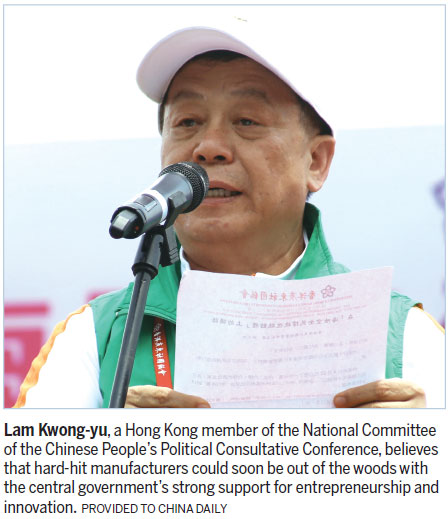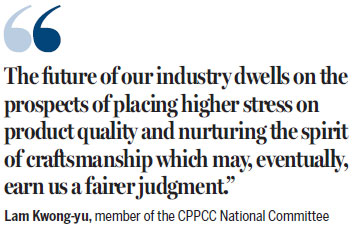Innovation, automation, brands key to survival
Updated: 2017-03-16 07:35
By Luo Weiteng(HK Edition)
|
|||||||||

Innovation, intelligent automation and self-owned brands hold the key for traditional manufacturers to survive and thrive, said Lam Kwong-yu, a Hong Kong member of the National Committee of the Chinese People's Political Consultative Conference and founder and chief executive of Starlite Holdings.
That may explain why he had never thought of relocating his enterprise from the Chinese mainland when his business almost hit the buffers five years ago.
"As manufacturing costs on the mainland soar, you may move the business to Southeast Asia. But then, the costs in Southeast Asia may also go up, and you may have to turn to Africa. But, what if the costs in Africa rise afterwards?" he asked. "This cannot solve the problem once and for all."
Instead, Lam chose to tackle the problem right at home by pushing for intra-organizational innovation and boosting their own brands.
Compared with starting from scratch, encouraging innovation in the company can make the utmost of its capital, connections and resources so as to lift the chances of success, he noted.
Thus, Hong Kong-listed Starlite - a multinational group that designs and manufactures cutting-edge printed packaging, as well as children's books and paper products - came up with its own eco-friendly products design brand Team Green and equipment brand Larsemann.
The use of a self-developed automation, intelligent robot system has vastly trimmed the number of workers from a record high of 13,000 to about 7,000 at present, accompanied by increased production efficiency and capacity.
Starlite aims to have one intelligent robot for every five workers by 2025.
Having said that, Lam added, the company still intends to relocate its business to target markets on either side of the Atlantic over the next three years, making them more responsive and flexible to the ever-growing capricious pool of customers. This is also one way of jumping on the Belt and Road bandwagon.
With the central government's unprecedented strong backing for mass entrepreneurship and innovation, Lam believed that such a big trend would ultimately steer the country's battered manufacturers out of trouble.
"Winter is coming, can spring be far behind? But, the point is what have you done for the winter? Without innovation, China, once known as the world's factory, will continue to feel the pinch from cheaper manufacturing bases in neighboring less-developed countries," he warned.
However, as the mainland continues to refocus from an export-driven, investment-intensive economy to an innovation-driven "new economy" - a buzzword for what's expected to be the country's next growth engine - Lam said this should never be taken to mean that the manufacturing sector's importance should be underestimated.
"An industry withering away should always be the natural consequence of market development rather than man-made selection and policy orientation," said David Wong Yau-kar, a Hong Kong deputy to the National People's Congress and chairman of the Mandatory Provident Fund Schemes Authority.
"The health of a nation's economy relies on its diversity, which dictates that the role of the manufacturing industry should not be neglected," he said.
Basically, the concepts of the so-called sunrise and sunset industries don't make any sense, and should never be applied to the manufacturing business, Wong reckoned.
Lam added that despite all the hype about the promising high-tech and financial fields, the manufacturing sector remains the backbone of China's real economy and in its quest to build brand recognition for the "Made in China" label.
"The future of our industry dwells on the prospects of placing higher stress on product quality and nurturing the spirit of craftsmanship which may, eventually, earn us a fairer judgment," Lam concluded.
sophia@chinadailyhk.com

(HK Edition 03/16/2017 page5)